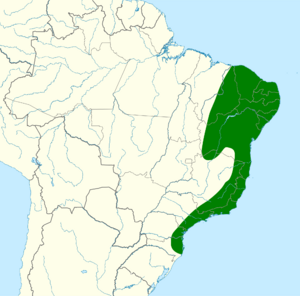Long-billed wren facts for kids
Quick facts for kids Long-billed wren |
|
|---|---|
 |
|
| In Registro, São Paulo, Brazil | |
| Conservation status | |
| Scientific classification | |
| Genus: |
Cantorchilus
|
| Species: |
longirostris
|
 |
|
| Synonyms | |
|
Thryothorus longirostris |
|
The long-billed wren (Cantorchilus longirostris) is a small bird from the wren family. It lives only in Brazil, which means it is endemic to that country.
Contents
About the Long-billed Wren
Scientists once thought the long-billed wren was the same species as the buff-breasted wren. However, they are now known to be different birds.
This bird has two main types, called subspecies. These are C. l. longirostris and C. l. bahiae. Some experts even think C. l. bahiae might become its own separate species one day.
What Does It Look Like?
The long-billed wren is about 19 to 21.5 cm (7.5 to 8.5 in) long. It weighs around 20 to 21 g (0.71 to 0.74 oz), which is about as much as a few quarters.
Adult birds have a dark brown head and neck. This color turns more reddish towards their back. Their tail is reddish-brown with darker stripes.
They have a light, off-white stripe above their eye. A darker stripe goes through their eye. Their cheeks are a mix of off-white and dark gray. They also have a blackish stripe near their beak.
Their throat can be whitish or a pale yellow-brown. Their chest is reddish-yellow, and their belly is a rich, deep yellow-brown. Young birds look similar, but their face markings are not as clear.
The C. l. bahiae subspecies is generally paler. Its belly colors are also much lighter than the other type.
Where Do They Live?
The C. l. bahiae subspecies lives in the northern part of eastern Brazil. You can find it from Piauí south to Minas Gerais. It also lives east towards the Atlantic coast.
The C. l. longirostris subspecies lives in a narrower strip along the coast. This area stretches from Bahia south to eastern Santa Catarina.
These birds like to live in different places. They can be found in new forests that are growing back. They also live at the edges of old forests and in clearings with shrubs. You might see them in mangrove swamps, caatinga (a dry forest), and restinga (coastal forests). They live from sea level up to 900 m (3,000 ft) high.
Behavior and Habits
How They Find Food
Scientists do not know much about what the long-billed wren eats. They also do not know much about how it finds its food. It probably looks for food alone or in pairs. It usually stays within 2 m (6.6 ft) of the ground. Sometimes, it might go as high as 5 m (16 ft) to find food.
Reproduction and Nests
The long-billed wren's breeding season seems to happen during the rainy season in its home areas. Its nest for raising young is shaped like a dome. It has an entrance tube that points downwards. These birds also build other nests, called "dormitory" nests, just for sleeping in.
Their Songs
Both male and female long-billed wrens sing. Sometimes they sing by themselves. Other times, they sing together in a duet. Their songs are described as "loud and varied."
Conservation Status
The IUCN (International Union for Conservation of Nature) has looked at the long-billed wren. They have decided it is a species of "Least Concern." This means it is not currently in danger of disappearing. The bird is often found in large numbers. It also lives in several protected areas.


